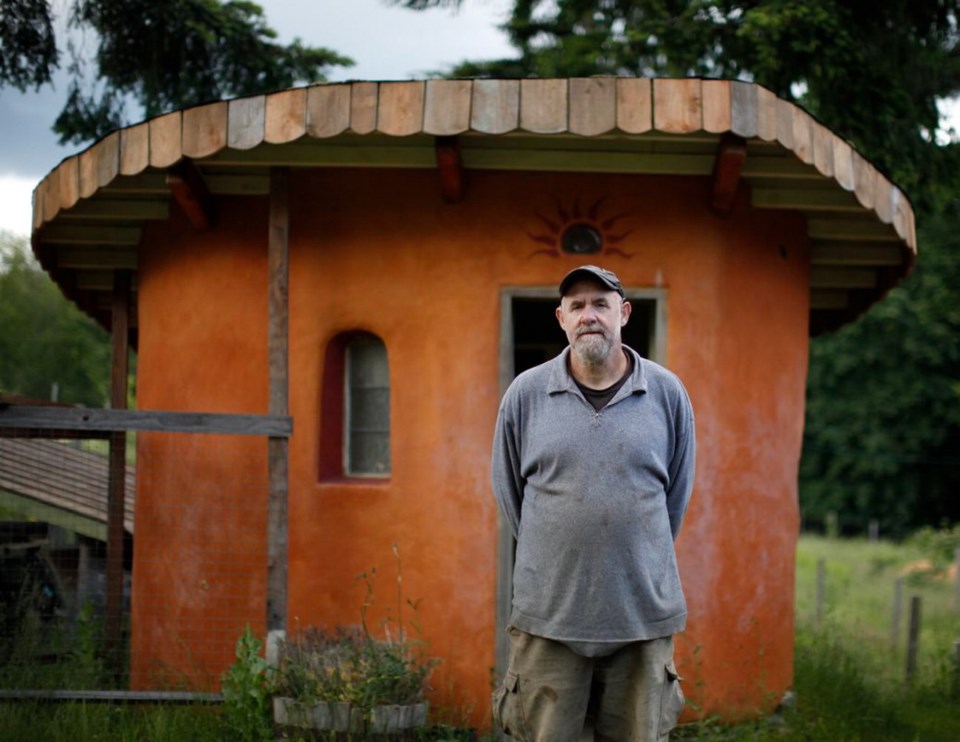Living in a cob house isn’t something homeowners do to blend with the neighbourhood, and Patrick Hennebery knows this firsthand.
He lived in a cob house on Mayne Island for 10 years.
Hennebery is the owner of Cobworks and routinely teaches workshops and internships, including a four-month course he’s currently conducting at Shawnigan Lake’s Our Ecovillage.
He estimates the house being built at the Ecovillage is his 24th cob home. “I’ve also built various small buildings, fireplaces, ovens, garden walls and benches.”
Cob is an ancient building material that has been used in some of the oldest human-made structures.
Using clay, sand, straw and water, Hennebery builds eco-friendly homes featuring other recycled and found materials, which helps keep construction costs down.
“On a conventional framed house, the labour is about half the cost,” he said. “With a cob house, the materials are way less, but the labour is still there.”
One advantage is that, unlike with a conventional house where you need a carpenter, much of the work associated with a cob house can be learned in a workshop, he said. “We encourage people to bring as much to the project as they can.”
Cob construction has recently increased in popularity on the West Coast. One reason people are choosing cob is the way the walls retain heat, helping to keep heating and insulation costs down.
But elsewhere in Canada, Hennebery said, those interested in building with cob would have to include natural building materials such as straw bales to help with insulation.
“I’m working on designing some small houses that would be good anywhere in Canada,” he said.
“You get the straw bales, which are good insulation, and cob, which has thermal mass. I want to design some houses where you have straw bale with a foot [30 centimetres] of cob inside. That way, no matter where, you can include the heating properties of both construction materials.”
Though Hennebery suggests cob construction is best suited to the West Coast’s climate, Gena Arthur, owner of Halifax’s Eco-Developments, is working on building her first cob house.
Arthur, who founded Eco-Developments in 2009 after travelling to Vancouver Island to learn about building with cob, said she started off small, building cob ovens. “I went on to build the first community oven in Nova Scotia, which is the Park Avenue Community Oven, which is built on the Dartmouth Commons.”
But building with cob on Canada’s East Coast is different than on the West Coast. Seismic activity in and around B.C. means builders here must meet requirements for foundations that building standards in Nova Scotia don’t have.
“I was able to obtain a permit to do a dry stacked stone foundation because we don’t have any seismic activity here,” said Arthur. “That was pretty major, because we did the very first permitted foundation.”
Another difference was wall thickness. According to Arthur, the walls for her home will be nearly a metre thick, unlike the 46-centimetre-thick walls Hennebery builds.
Arthur said she will be adding walls and a roof to her home in the next three weeks with the help of an apprentice from Providence, R.I., and nearly 60 interested volunteers.
“The interest from the public has been phenomenal,” she said. “We have hundreds of people that are waiting to come and see our project, and we’ve just been holding off because it isn’t much right now.”
Online:
www.cobworks.com
ourecovillage.org
eco-developments.ca



